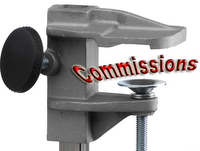Commission Fees water down Expectancy
 I have talked about position sizing and I have talked about expectancy.
I have talked about position sizing and I have talked about expectancy.If you understand the proper positing sizing algorithms and positive expectancy, you would think that you are on the road to riches or at least to a system that returns a profit. Not so fast! What happens when commissions start to eat away at the profits you thought you would have at the end of the year? Many investors have a winning system with a positive expectancy but that might not be profitable in the end when adding in the heavy toll of commissions.
As I have stated in previous posts, expectancy will tell you if your system will be profitable over time but you must use a position sizing calculation in order to trade the proper amount or you could be broke before you know it. Trading too large will send you to the poor house on your first or second major mistake. You don’t want to dig yourself into a hole you can’t climb out of with a positive expectancy system. It would be a sin to have developed a positive expectancy system, only to be ruined by commissions.
I am not a day trader although I continue to see advantages each and every day as I learn more about many of the advanced techniques of professional investing. Under my current system of investing (call it trend trading, momentum trading or swing trading), I pay a commission of $9.95 on each end of the trade (I rarely use limits but they cost a few dollars more on each end). That is cheap in my estimation but the more I increase my activity, the higher my costs become and the lower my expectancy becomes when adding in this major factor. Besides, I don’t have the advantage of using 4-to-1 margin the same way a day trader can leverage their account and position sizing algorithm. Day traders typically pay commissions per share rather than paying on each end of a “total trade”. From what I understand, this breaks down to a much cheaper structure as long as minimum trading levels are reached. If these levels are not reached, penalties may be applied but check with your own broker before you take my word for it.
I typically place the entire trade when I get a signal and use retracement stops to get out of a position to capture gains so I am only required to pay commissions once on each end. In tough markets, I will place tester buys but I also understand that my commission fees will accumulate due to the fact that I scale into the position and sometimes scale out. If I only place 1/3 of my anticipated position on the breakout in a weak market, my $20 round trip commission could accumulated to $40, $60 or $80+ based on the number of scale-ins or scale-outs I use. Using my current style of momentum trading, I can handle these larger commissions because I am aiming to capture larger gains per trade than most day traders. I am looking for the 25% initial breakout gain that accompanies many CANSLIM type stocks. Looking forward, I am developing systems that trade more frequently so I can realize my calculated expectancy over a specific number of trades. Since my number of trades will increase and my individual profits per trade will decrease, I want to minimize my commission fees.
It is very important to factor in commissions when calculating your overall expectancy. If your expectancy is positive but only slightly, be wary that higher commissions may push this number into negative territory. Weigh all factors before implementing a system that looks good on paper but actually comes out negative and gives you no chance of winning over the long term. A negative expectancy system (including commissions) will make you go broke if you continue to trade it. Think of that casino analogy; gamblers will go broke playing the tables in Vegas because the odds are against them. They may make a few big scores but in the end, the casinos take it all! Trade a negative expectancy system and the markets will take it all!
I love the movie Casino and there is a scene in this movie when Robert Di Niro develops a plan to keep a high stakes gambler at the casino so he can continue playing (to give back the money he won by luck – he made a big score). Di Niro (the casino manager in this movie) knows that the shark will lose if he continues to play because math never lies and the game of baccarat has a negative expectancy geared towards the players. Again, this is why I play poker at the casinos (they get a rake but that is just a commission fee in my mind as the positive expectancy is based on me playing the odds)!
Piranha





0 Comments:
Post a Comment
<< Home